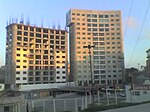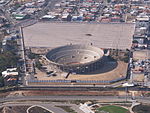Smuggler's Gulch

The Smuggler's Gulch is part of a steep walled canyon about 2 miles (3.2 km) inland of the Pacific Ocean. The canyon crosses the Mexico–United States border, between Tijuana, Baja California, and San Diego, California, and Smuggler's Gulch is the part of the canyon on the US side of the border. It may also be called Cañón del Matadero or Valle Montezuma in Spanish, but these names apply more generally to the whole canyon. Smuggling activities within Smuggler's Gulch have occurred since the 19th century, giving this part of the canyon its name. The gulch is vegetated with coastal sage scrub and is home to threatened and special concern bird species. It has a seasonal stream, and normal flow is diverted for treatment. During the late 19th and early 20th centuries, agriculture occurred in the gulch, but was largely abandoned by the late 20th century. In the late 20th century, the gulch was used by illegal immigrants when crossing from Mexico into the United States, being described as a "prime route" during that period. Beginning in the 1980s, sewage flowing through the gulch entered into the Tijuana River, contributing to water contamination; since then mitigation efforts have been undertaken, but are defeated by rainfall. Since 2009, it has been partially filled and traversed by the Mexico–United States barrier.
Excerpt from the Wikipedia article Smuggler's Gulch (License: CC BY-SA 3.0, Authors, Images).Smuggler's Gulch
Monument Road, San Diego Tijuana River Valley
Geographical coordinates (GPS) Address Nearby Places Show on map
Geographical coordinates (GPS)
| Latitude | Longitude |
|---|---|
| N 32.5447789 ° | E -117.088361 ° |
Address
Monument Road
Monument Road
92173 San Diego, Tijuana River Valley
California, United States
Open on Google Maps





